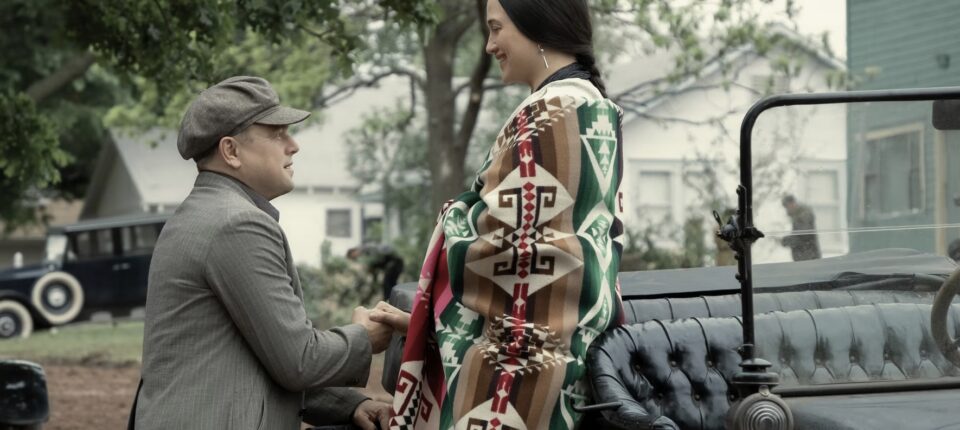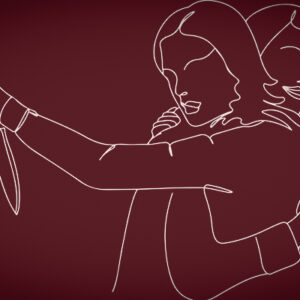The night I saw Killers of the Flower Moon I dreamed wildly, fitfully. Until I went to bed, I spent my waking hours thinking about the film, and then I suppose I continued to think about it as I slept. I have many questions about it. There are so many details I’d like to discuss. I wish I had seen it with friends, rather than (as is customary for my job) by myself with only my notebook to aid in exegesis. Killers of the Flower Moon, which was directed by Martin Scorsese, screen-written by Scorsese and Eric Roth, and based on the monumental nonfiction book of the same name by David Grann, is a tremendous feat of filmmaking, but it’s not a simple one, not an easy one.
Killers of the Flower Moon unfolds on a heretofore obscure event in the history of 20th-century America: the regional genocide of the Osage people during the 1920s. David Grann’s book, published in 2017, is responsible for bringing this history to a wide national audience. In the 1870s, the United States had removed the Osage Nation from their lands in Kansas, relocating them to a reservation in an undesirable, inhospitable patch of land in Northeast Oklahoma. But that land turned out to be rich with oil, and the Osage people quickly became wealthy. In the 1920s, Grann notes, the Osage were the wealthiest people (per capita) in the whole world.
In this region, the usual socioeconomic dynamics of America had been upended—the long-oppressed Native people had access to a kind of life that had exclusively been designed and intended for white people. And because of this, the Osage people found themselves in terrible danger. The white men in the town began to kill the Osage for their money—but not simply that, as if that isn’t terrible enough. The Osage people were courted, cornered, cajoled, conspired against, and legally captured by the greedy, jealous white people in the region—swearing friendship and loyalty, ingratiating themselves into their families, marrying into the Nation, taking control of their finances, and milking them every way they could. Killing them was only the final step in the systematic destruction, dilution, dehumanization, and devastation of an entire people, culture, and history. It is an act of such profound evil that it seems both impossible to comprehend and all-too-possible to believe happening in America.
In a way, the sprawl of the film is too great.Martin Scorsese’s Killers of the Flower Moon begins with the story of the Osage Nation’s windfall, but quickly shifts perspective, filtering it through the eyes of a white outsider, Ernest Burkhart (Leonardo DiCaprio). A World War I veteran, Ernest travels to Oklahoma to live in the home of his uncle, William K. Hale (Robert De Niro), an affluent cattle rancher who prides himself on his friendship with the Osage. He has positioned himself as both a benefactor and steward of the Osage people, using his influence to provide them access to fine goods and vanguard healthcare, centralizing himself in their proceedings and culture. He speaks the Osage language, he lightly arranges marriages between some white men and Osage women, he becomes a trusted force in the Osage County way of life. That he likes to be called King suggests that his deference is a ploy, that he has disguised self-interest as benevolence. It’s not long before Ernest—plain-spoken, dim, impressionable, giggly, and acquisitive—notices Mollie Kyle (Lily Gladstone), a beautiful, pensive, no-nonsense Osage woman. Working as a cab driver in the town, he flirts with her, tries to get to know her. Hale approves of their mingling, informing Ernest that Mollie’s full-blooded Osage status means that she has full headrights to her family’s wealth. Ernest is attracted to Mollie’s lifestyle as much as (if not more than) he is attracted to her. When they marry, countless Osage men and women have already been reported dead (of causes ranging from health issues to gunshots), but the film is not ambiguous about the connectedness of the murders to each other, as well as acts of swindling and robbery of the Osage people that have been taking place in the background—acts that Ernest is already involved in.
Grann’s book is a little more openended about who exactly committed many of these uninvestigated, unprosecuted, and unsolved murders—he puts forth compelling theories, but ultimately is unable to state conclusively given how much time has passed and how little hard evidence there is. But it does tie a conspiracy together under Hale’s aegis (one of many masterminds of numerous plots against the Osage). The book’s main frame is Mollie finding herself at the center of the mass death of her people and family. A secondary, later frame is the work of a man named Tom White, an agent with the nascent Federal Bureau of Investigation who is eventually sent to figure out why so many Osage are dying (he’s played in the film by Jesse Plemons, but it’s a rather small role). Then, Grann’s book unfolds a story about the birth of the FBI. Scorsese’s film is less interested in the investigation than the machinations of Hale, Ernest, and other white men—as well as Ernest and Hale’s ability to justify killing of a group of people who are not only their Osage neighbors and friends but also literally their own family. These murders are myriad and slow, part of an overall poisoning of Osage culture, heritage, and lifestyles. Most of these murders unfold as creative acts of nutritional and psychological torture; the white men have gotten the Osage addicted to alcohol and to sugar, encouraging their spirals into depression and despair.
The film counts down the deaths of Mollie’s family—her two sisters, Minnie (Jillian Dion), Anna (Cara Jade Myers), and her cousin Reta (JaNae Collins)—as well as Hale’s close friend Henry Roan (William Belleau). Mollie knows that she is next. She doesn’t know that Hale and Ernest are poisoning her, too. Ernest seems genuinely fond of her but has (as a white supremacist, as all of these white people fundamentally are) accepted the idea that helping to kill his wife’s family is just something he has to do.
Scorsese’s film, which is 3 hours and 26 minutes, is a gut-wrenching story told with ample thought and care—it is clearly invested in doing right by the Osage people of then and now. The Osage’s participation in the making of the film has been well-publicized, but it’s clear, when viewing the film, that Scorsese not only wants to get the historical details right without exploiting the Osage or their suffering but that he also wants to tell the story in the most respectful, collaborative way possible. In one scene in particular, Scorsese acknowledges a kind of lurid true-crime reportage that (he wants to make clear) this film is not. At the same time, in order to be its most respectful and compassionate version, the film might have focused less on Ernest. Scorsese likes an antihero, and a man who experiences such absurd self-denial that he can’t fully understand the impact of his being a serial killer annihilating his wife’s family for personal gain, is certainly that kind of protagonist. Scorsese is perhaps too curious about fleshing out Ernest’s feelings and conflicts instead of accepting that he is a walking contradiction, made into such by white supremacy. It seems very easy to understand that a man like Ernest Burkhart, an idiot fashioned into his true self by cultures of racism and misogyny, might believe he loves his Osage wife and yet find it justified to kill her entire family, because he subconsciously he regards them all as things to possess, property to be claimed, resources to be mined.
Gladstone is the film’s glowing center, and whenever she is not onscreen, her absence is not only palpable but painful.Most of the performances in the film, from Lily Gladstone’s almost-cipher-like Mollie to Jesse Plemons’s awkwardly-dogged detective White, are excellent. Gladstone, in particular, is the film’s glowing center, and whenever she is not onscreen, her absence is not only palpable but painful. Killers of the Flower Moon also boasts a fantastic ensemble of character actors, including John Lithgow, Louis Cancelmi, Ty Mitchell, Gene Jones, and the great Tantoo Cardinal as Mollie’s mother, Lizzie Q.
Scorsese has referred to both DiCaprio and De Niro as his muses, and frankly, I wish he’d get some new ones. As Ernest, DiCaprio delivers a solid performance, but it’s the kind of frowny-faced, Southern-drawly one we’ve seen a lot of from him—I found his performance cartoonish and lacking any of the particularized pathos he tries hard to summon. De Niro, while obviously a more than capable actor, delivers a serviceable performance, but it feels wrong for the film. Maybe it’s hard to see De Niro as a small-town guy. His Hale is almost distractingly recognizable, out of place (and occasionally slipping into his New York accent). No one’s better than De Niro at playing dangerous when it takes the form of creepily calm, but this isn’t Hale’s vibe. Hale—a charismatic bureaucrat—should seem more unassuming. I’d want a Michael Stuhlbarg, a Tracy Letts, maybe a Henry Czerny. I’d want a Burl Ives type—someone who could entwine paternalism with paternity. John Goodman?—someone who could entwine paternalism with paternity. John Goodman? Then again, I find myself wondering if Jack Nicholson from a decade ago could have pulled it off—he’s maybe a little too palpably sinister, but even that feels more in line with the film’s thematic trajectory.
Anyway. The film’s long runtime promises immersion in this time and place, but I still found myself at times feeling like a stranger there; I’d forget who some side characters were rather than recognize them as if they were my fellow townsfolk. In a way, the sprawl of the film is too great—and again, I think this is because the film spends so much time mapping out Ernest’s emotional states. But technically, the film is extraordinary—as a gallery of shots, it’s mesmerizing. Scorsese loves to play with cameras (inside and outside the frame) and ask questions about media, and this reliably innovative approach also breaks up the narrative when it starts to sag.
The emotional weight of what Scorsese has achieved with Killers of the Flower Moon is significant; the night I saw the film, I dreamed about some of the film’s most dramatic scenes from the perspective of a tormented spectator, the same tormented spectator I was when literally watching the film. In my dreams, I’d be running towards imminent, heartbreaking disasters, yelling at characters to run away, to turn around, and I could never arrive in time, never save anyone. Despite some of its pitfalls, Scorsese’s film swells with humanity and heart, leaving a tremendous impression of the real-life horrors that took place in Osage County in the 1920s. He removes the distance between our moment and this one, a century before, making us feel the horrors that happened to the Osage people—people who, after centuries of persecution and belittlement, were finally given a share of American prosperity and were forced to pay a price for it.

















